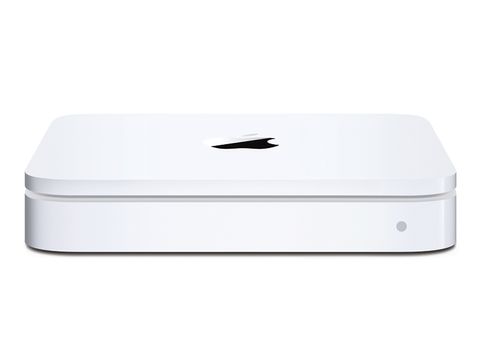TechRadar Verdict
The price may be indefensible, but Time Capsule remains a brilliant backup solution
Pros
- +
Very easy to use
- +
n & g networks run at full speed
- +
USB disk and printer sharing
Cons
- -
Stupidly expensive
- -
No built-in modem
- -
Slow initial backup
Why you can trust TechRadar
When we reviewed the first-generation Time Capsule, we were impressed. The basic concept – taking the powerful and easy-to-use AirPort Express wireless base station, scaling it up a bit and stuffing a hard disk inside – was good enough on its own.
But when paired with Time Machine, the backup engine in Mac OS X 10.5 Leopard, it was a genius product.
The idea is that once you've set up Time Capsule and pointed all your Macs to its internal hard disk as their target backup volume, you're done.
After the big initial backup, every hour the Time Machine engine on each Mac would copy new or changed files to Time Capsule, automatically. You didn't have to remember to run the backup or tell it what to back up. You didn't even have to set up a schedule.
All the files necessary to rebuild your system completely, even if your hard disk failed, were automatically copied across your wireless network, and even if your data loss was less catastrophic, the Time Machine interface made it easy to reach back in time to rescue an earlier or deleted version of a file.
Subtle changes
And it's just as well we liked the first version, because this version isn't that different. There are essentially only three new features.
Time Capsule now has a pane for you to enter your MobileMe login details. When you do, Time Capsule and any disks connected to its USB port, show up in the Finder sidebar of any other of your internet-connected Macs regardless of where they are.
Next is the ability to create a separate guest network, allowing visitors to access the internet, while keeping your other computers safe. Again, we can't think why this couldn't be added to older models.
The big new feature, however, is the dual wireless channels. In a wireless network, data travels as fast as the slowest device connected. You may have an 802.11n base station and three 802.11n Macs, but as soon as you switch on (say) your iPhone, the network slows to 802.11g speeds.
Double speed
With dual channels, n traffic can flow at its full speed, even with g devices connected. Benchmarking with Helios LanTest suggested an average read-speed of 1.6MB/sec for g devices, jumping to almost 6MB/sec for n.
You can also create a 5GHz network, though in our tests at least, this brought only marginal increases, adding another half a megabyte per second or so to the throughput.
It's an easy backup strategy, though our original criticisms from the first version (that the initial backup can be slow, with no help showing you how to do it over Ethernet, then switch to WiFi. Or that restoring your system can be sluggish and that Apple still refuses to add a modem) can be made of this version too. Worse, the price seems ludicrous in these days of sub-£100 terabyte drives.
Buy from our Affiliates: Amazon | John Lewis

